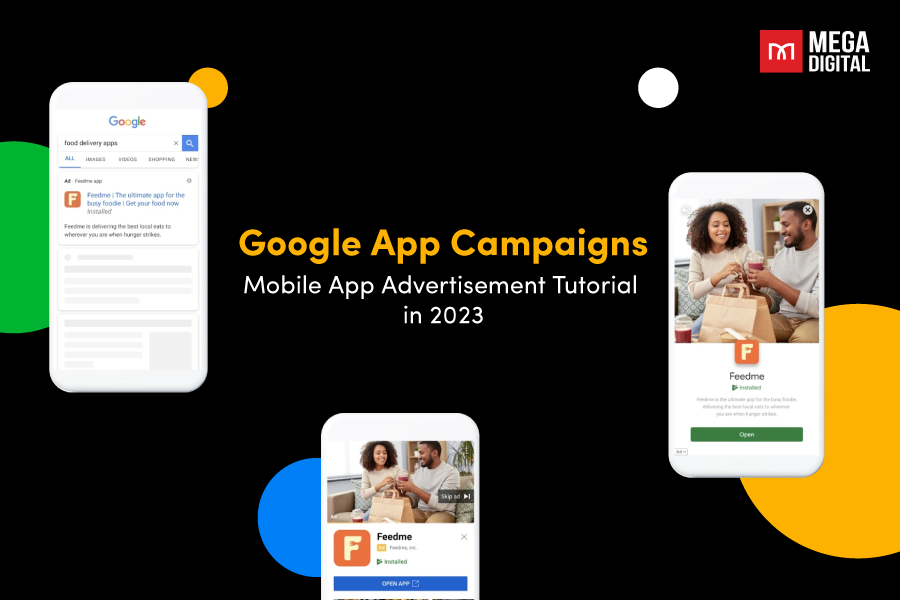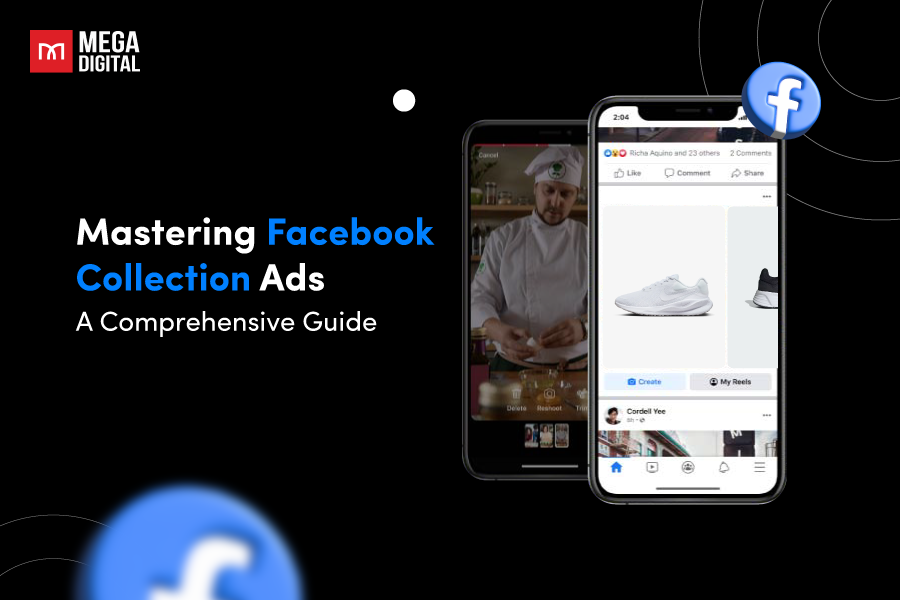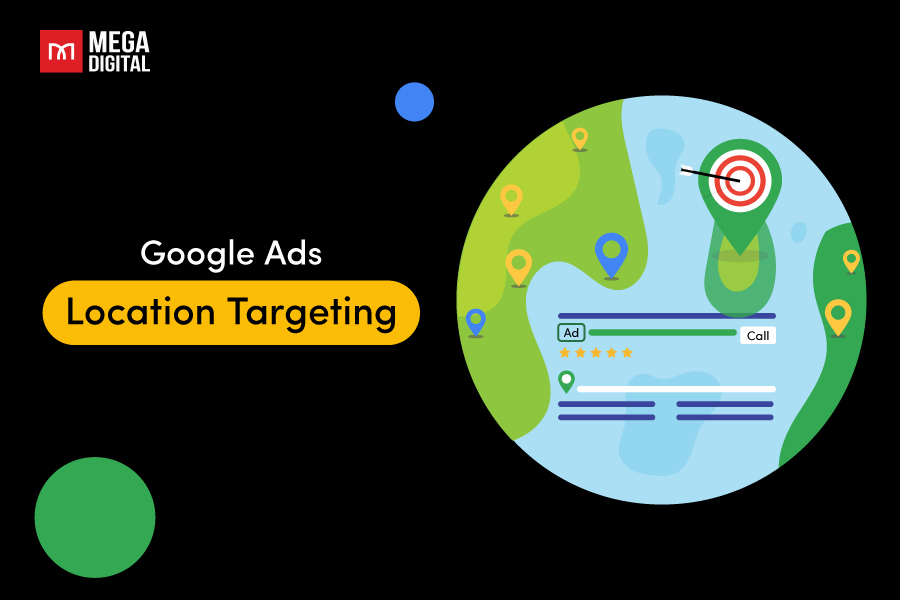Targeting the right audience online can be a frustrating game of chance. But what if you could leverage your most valuable asset – your existing customer data – to reach the perfect audience every time? One such tool that’s help you do that is Google’s customer match list. In this blog, I will explain what Google Customer Match is, and show you ways to unlock the power of targeted advertising with this feature.
- What is Customer Match in Google Ads?
- How Does Customer Match List Work?
- Key Benefits of Using Google Customer Match
- Some Google Customer Match Requirements to Follow
- Customer Match and Remarketing Lists: What’s the Difference?
- How to Build a Google Ads Customer Match List?
- 5 Strategies to Leverage Customer Match List
- 5 Common Mistakes With Google Customer Match to Avoid
- Case Study: How Business Utilizes Google Ads Customer Match List?
- Frequently Asked Questions (FAQs) about Google Ads Customer Match List
- 1. What is Google Ads Customer Match List?
- 2. What types of customer data can be used in a customer match list?
- 3. Is there a minimum audience size for a customer match list?
- 4. How long does it take for Google to process a customer match list?
- 5. How often should I update my customer match list?
- 6. Can I use customer match for any type of campaign?
What is Customer Match in Google Ads?
Google Customer Match is a unique feature from Google Ads that allows businesses to input their online and offline data to directly match customers across Google’s suite of platforms, including:
- Search
- Google’s Shopping
- Gmail
- YouTube
- Display ads
In addition to targeting specific customers whose data is already on hand, Customer Match lets you target other customers like them, opening up your PPC ads to a broader audience of prospects that are already vetted without you having to do all that work yourself. The data used in Google Customer Match is so valuable as it comes directly from your customers.
How Does Customer Match List Work?
Once you have collected information about your customers, such as their email addresses, phone numbers, or physical addresses, you can upload it to Google Ads. This is done by creating a data file and uploading it to your Google Ads account.
After you have uploaded the customer information, Google will then match this information with its users. Google uses a process called hashing to ensure that the customer information you upload is secure. Hashing is a process that converts the customer information into unique strings of characters, which Google then matches with the hashed versions of the same information that it has on file for its users.
Once Google has matched the customer information with its users, you can then create a campaign that targets the Customer Match list. You can choose to target or exclude the customers on the list in your campaign.
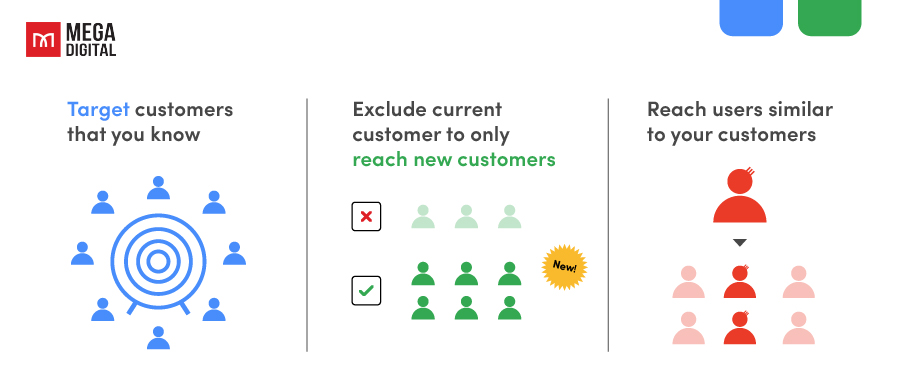
Key Benefits of Using Google Customer Match
Enhanced Targeting Precision
By uploading your existing customer data, you can directly reach users who have already interacted with your brand in some way. This eliminates the guesswork involved in traditional targeting methods and ensures your ads are displayed in front of a highly relevant audience segment.
Boost brand awareness among existing customers
Staying top-of-mind with your existing customer base is crucial for fostering loyalty and repeat business. Google Customer Match lets you showcase your latest offerings and promotions directly to your existing customer pool. This can be particularly effective for promoting new product launches, seasonal sales, or loyalty programs.
Improved customer retargeting
Re-engaging past website visitors, app users, or email subscribers is a fantastic way to reignite interest and drive conversions. Google Customer Match allows you to create custom audience lists specifically for these past interactors. You can then craft tailored messaging that reminds them of your brand offerings, highlights new products or promotions, and ultimately nudges them back towards completing a purchase or desired action.
Better ROI
By targeting your ads to customers who are most likely to be interested in your products or services, you can improve the return on investment (ROI) of your advertising campaigns. This means you can get more value from your advertising budget.
Enhanced customer insights
Google customer match provides valuable insights into your customers’ behavior. You can use these insights to refine your marketing strategies and make more informed decisions about your business.
Some Google Customer Match Requirements to Follow
To use this tool, businesses must meet some requirements set by Google:
- You must have a good history of policy compliance: This means that businesses must adhere to all of Google’s advertising policies, or else they will be ineligible to use Google Customer Match.
- Your account must have been open for at least 90 days: Google wants only businesses with a track record of advertising on the platform can use Customer Match.
- You must have spent more than $50,000 in Google Ads: This requirement helps ensure that Customer Match is used by businesses that are serious about their advertising efforts and have a significant investment in Google Ads.
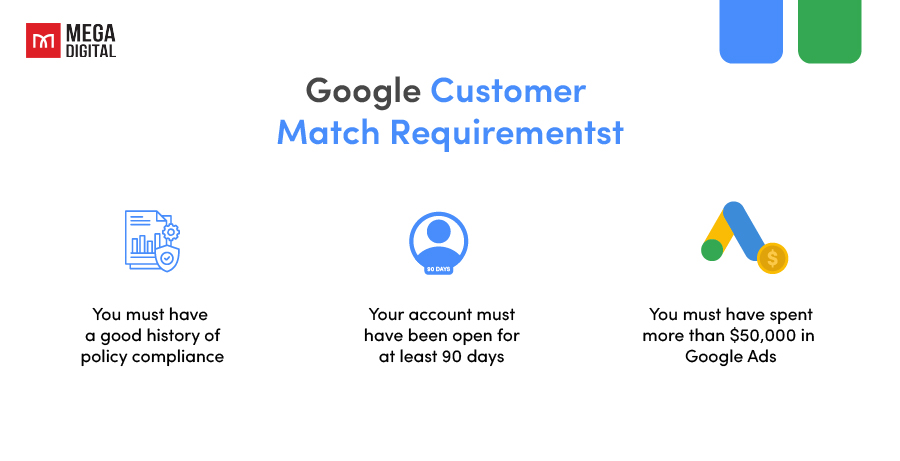
Additionally, there are some requirements that businesses need to follow to use Google Customer Match, as well as features available to advertisers, based on which requirements they satisfy. You can find a detailed list of these requirements on Google’s Customer Match policy page.
If an account fails to meet these Customer Match list requirements, your account will be subjected to a compliance review. If any non-compliance is detected, the account manager will receive a notification and is expected to take action to rectify the situation swiftly. If no corrective action is taken, your account can be suspended.
Customer Match and Remarketing Lists: What’s the Difference?
While both Google Customer Match and Remarketing Lists for Seach As serve the purpose of targeting specific audiences for your ads, they achieve this through distinct approaches. Here’s a breakdown of the key differences between these two functionalities:
| Customer Match Lists | Remarketing Lists for Seach Ads (RLSA) | |
|---|---|---|
| Targeting Method | Uploads of customer data (email addresses, phone numbers, mobile advertising IDs) | Website cookies, app user IDs, or Google Signals |
| Targeting Scope | Reaches users who have already interacted with your brand in some way (existing customers, past website visitors, app users) | Reaches users who have interacted with your website or app but haven’t converted yet |
| Data Source | Your CRM, email marketing platform, or other internal databases | User activity on your website or app |
| User Consent | Required for email and phone number uploads (not required for mobile advertising IDs) | Not required |
| Minimum List Size | Varies depending on location and account history (generally a few hundred to a few thousand users) | No minimum requirement |
How to Build a Google Ads Customer Match List?
- Start by signing in to your Google Ads account.
- Click on the tools icon. Under the “Shared Library” section, choose “Audience Manager”.
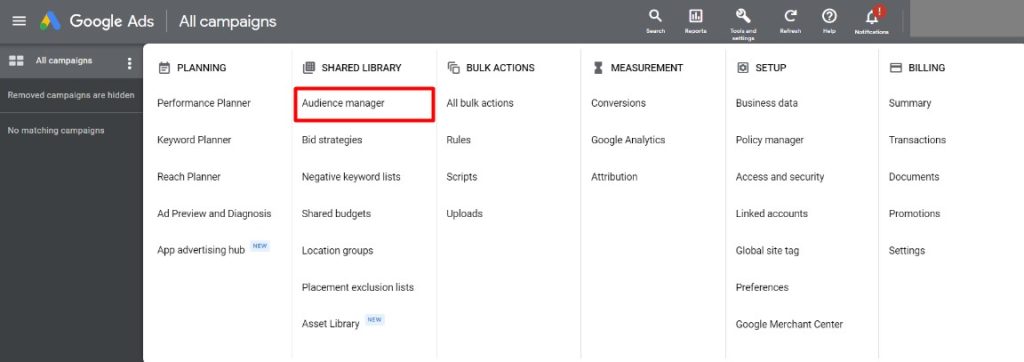
- Select “Segments” from the menu on the left and click on the blue “+” button.
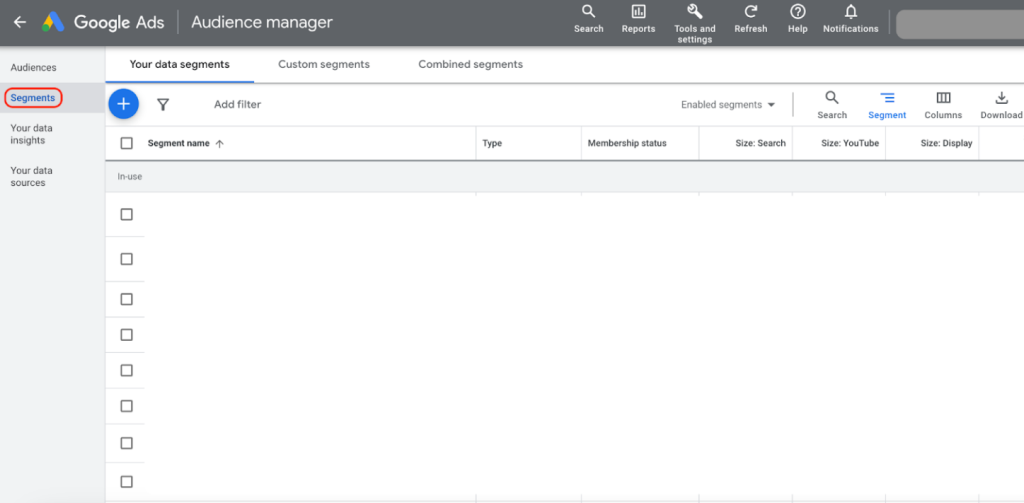
- Click on “Customer list”.
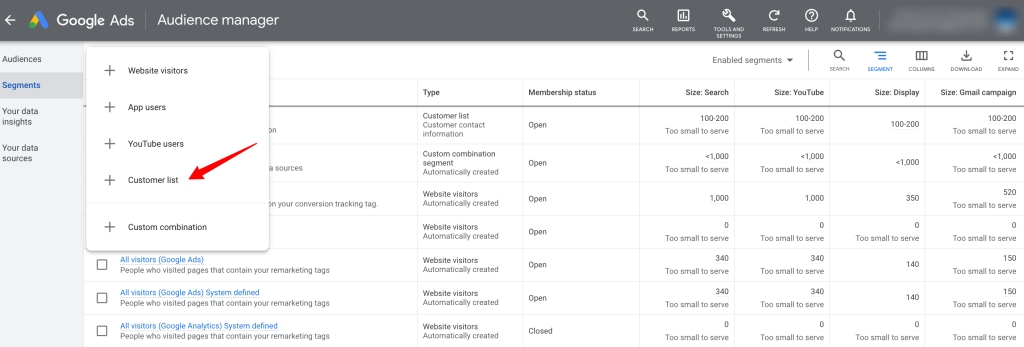
On the Customer list screen, set up your new list. Start by naming your list, then upload your list of customer emails, phone numbers, and mailing addresses. You can choose the option to upload a plain text data file or a hashed data file.
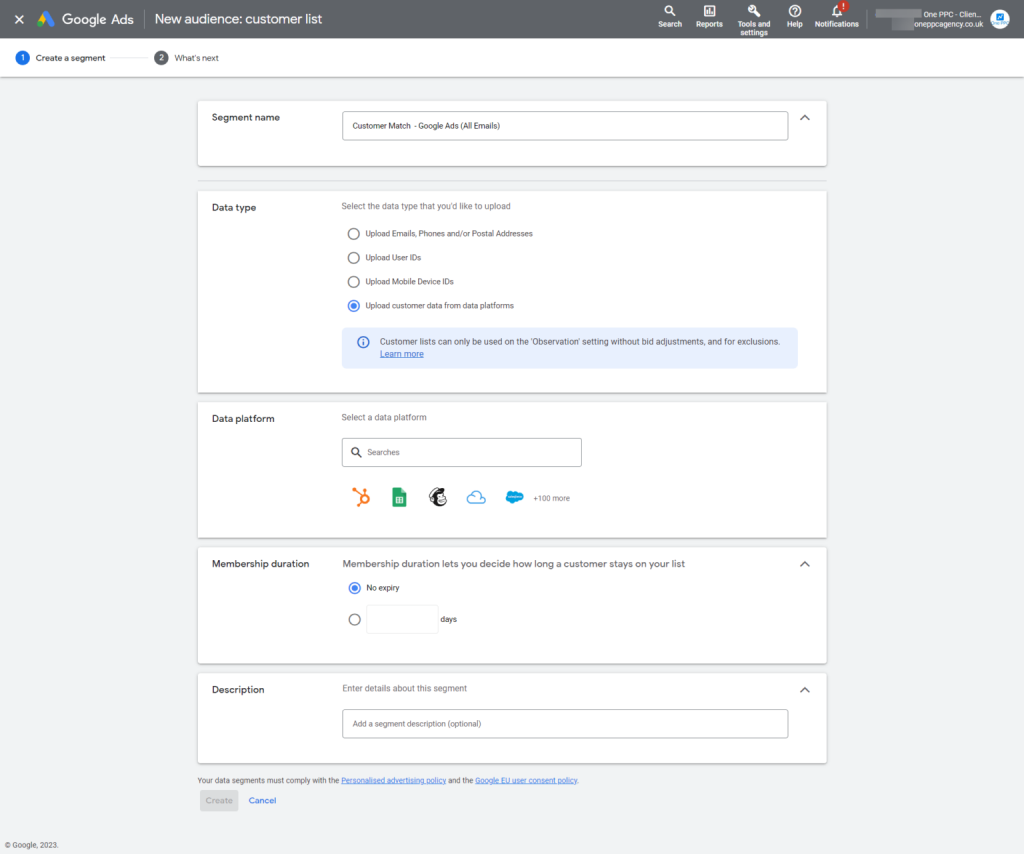
Once completed, click on “Upload and create”.
The process of uploading your list to the audience lists typically takes around 48 hours. Once the audience list is ready, you can refine it further using the insights tool.
Remember, the information you upload is matched with Google users in a secure and privacy-safe way.
5 Strategies to Leverage Customer Match List
Google Ads Customer Match is not just about re-targeting. It’s about reaching your most valuable customers and understanding their journey. You can leverage your customer match list by following these strategies:
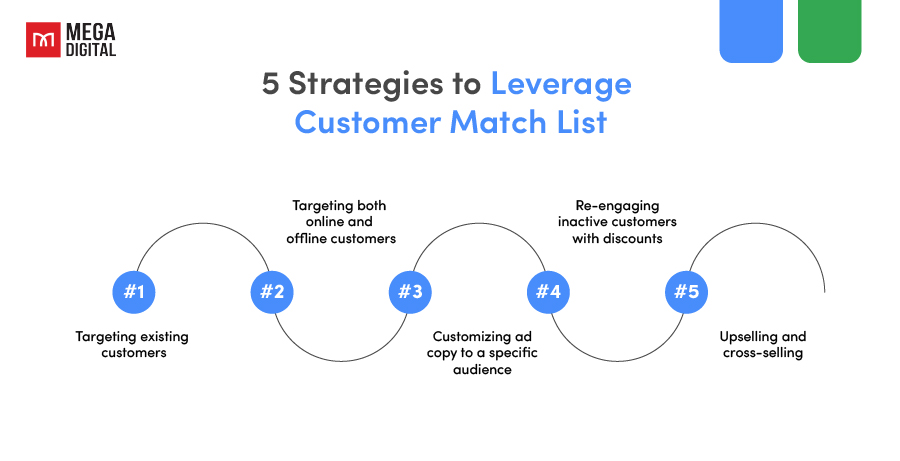
#1. Targeting existing customers
This strategy involves using your existing customer data to create highly targeted and personalized ad experiences. By uploading a list of customer information to Google Ads, Google matches this information with its users, allowing you to target ads specifically to these matched users. This can lead to higher engagement and conversion rates, as ads are more relevant to the customers they are targeting.
#2. Targeting both online & offline customers
Google Customer Match allows you to reach your customers wherever they are, whether they’re online or offline. For online targeting, you can reach your customers across different Google products, including Search, Shopping, Gmail, and YouTube. For offline targeting, you can use data from offline sources, such as in-store purchases, to create a list of customers to target.
#3. Customizing ad copy to a specific audience
With Google Customer Match, you can customize your ad copy to resonate with a specific audience. This means you can tailor your messaging to meet the specific needs and interests of your customers. This level of personalization can significantly enhance the effectiveness of your ads and ultimately drive higher ROI.
#4. Re-engaging inactive customers with discounts
Reactivating past customers who haven’t engaged with your brand in a while is a cost-effective way to boost sales. Utilize your Customer Match list to identify lapsed customers and craft targeted campaigns designed to win them back. Offer them exclusive discounts, highlight new product launches, or simply remind them of the value your brand offers.
#5. Upselling and cross-selling
Show your existing customers new products or services that complement what they already bought. This not only increases your sales but also enhances customer satisfaction and loyalty.
5 Common Mistakes With Google Customer Match to Avoid
#1. Not Updating the List Regularly
One of the most common mistakes is not updating the customer match list regularly. Your customer base is not static – it grows and changes over time. Regularly updating your list ensures that you are reaching out to all your current customers.
#2. Ignoring the Quality of the List
The quality of your customer match list is crucial. A list filled with outdated or incorrect information will not yield good results. Make sure the information you have on your customers is accurate and up-to-date.
#3. Not Segmenting the List
Each customer has different needs, preferences, and behaviors. Segmenting your customer match list allows you to target your ads to specific groups of customers, making your ads more relevant and effective.
#4. Overlooking Privacy Concerns
Privacy is a major concern for customers today. It’s important to respect your customers’ privacy when using customer match. Make sure you have obtained your customers’ consent to use their information for advertising purposes.
#5. Not Monitoring Performance
Once your customer match campaigns are launched, don’t just set them and forget them. Regularly monitor their performance to see what’s working and what’s not. Analyze metrics like click-through rate (CTR), conversion rate, and cost-per-acquisition (CPA) to identify areas for improvement and optimize your campaigns for better results.
Case Study: How Business Utilizes Google Ads Customer Match List?
Teknosa, a leading electronics retailer, successfully leveraged the power of Google Customer Match to enhance their marketing strategy.
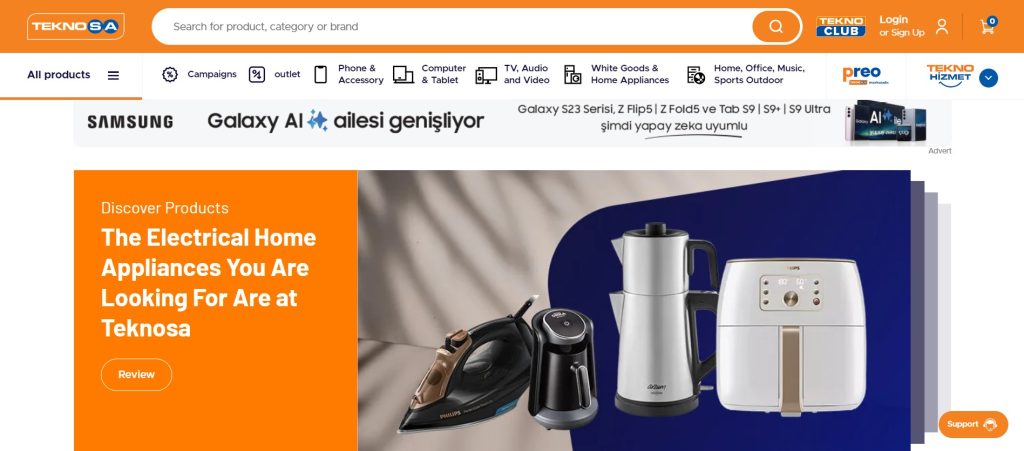
Challenge
Teknosa wanted to make the most of their existing campaigns and target their most valuable customers when they searched for relevant products.
Strategy
Teknosa decided to use Google Customer Match, which allowed them to upload their customer data to Google Ads and target ads specifically to these matched users.
Results
Teknosa achieved a 47% better cost per acquisition and a 112% higher return on investment than their existing remarketing campaigns. This success was attributed to the ability of Customer Match to target Teknosa’s most valuable customers with relevant ads.
Frequently Asked Questions (FAQs) about Google Ads Customer Match List
1. What is Google Ads Customer Match List?
Google Ads Customer Match List is a feature that allows advertisers to upload a list of customer data that Google then matches to users within its ecosystem. This enables businesses to target ads to existing customers, re-engage with dormant customers, and find new customers similar to their best ones.
2. What types of customer data can be used in a customer match list?
Advertisers can use email addresses, phone numbers, and physical addresses for Customer Match. Google also allows the use of Mobile Device IDs for app users.
3. Is there a minimum audience size for a customer match list?
Yes, Google requires a minimum audience size of 1,000 matched users to maintain anonymity.
4. How long does it take for Google to process a customer match list?
It typically takes up to 48 hours for Google to process a Customer Match List.
5. How often should I update my customer match list?
It’s recommended to update your customer match list regularly, at least every 30 days, to ensure that your ads reach the most relevant audience.
6. Can I use customer match for any type of campaign?
Customer match can be used for Search, Shopping, Display, and YouTube campaigns. However, it’s not available for all types of campaigns, such as Smart campaigns.
Final Words
In conclusion, Google Customer Match is a powerful tool that allows businesses to leverage their online and offline data to reach and re-engage with their customers. It’s a game-changer tool, providing businesses with unique opportunities to grow their customer base and drive loyalty. So, if you haven’t started using Google customer match yet, now is the time to explore its potential and see how it can help your business thrive in the digital age.







